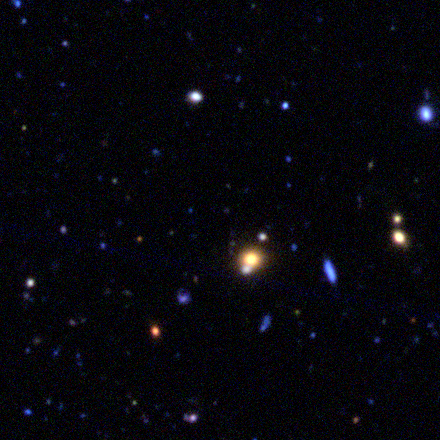The splitting of light from a quasar though a lens.
-
 by
Budgieye
moderator
by
Budgieye
moderator

This image is from the Spotter's Guide, showing quasar points balanced on both sides of nucleus.
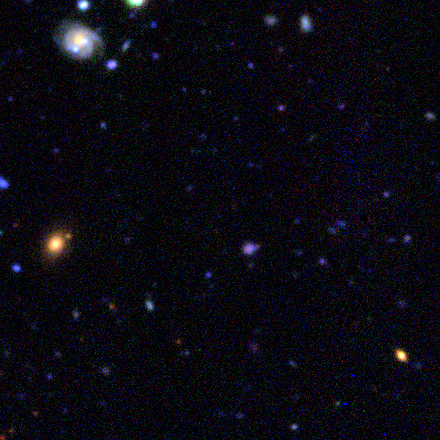
http://talk.spacewarps.org/#/subjects/ASW0001g7d
This is a training image, a simulation, a #sim.I thought this could not be a #double quasar, because the two quasar points were not centered around the nucleus of the galaxy.
Is this simulation a true representation of what can be expected, or is it a #simfail?
Posted
-
 by
Budgieye
moderator
by
Budgieye
moderator
From Spotter's Guide
Below the examples show quasars lensed by a single galaxy, quasars lensed by a galaxy group are even rarer. To date, only three quasars lensed by a galaxy group/cluster have been found.

Image of Einstein cross, quadruply lensed quasar, #quad from Spotter's guide.
A few months ago psaha gave me a test question, why does a #quad quasar have 4 points.
I know that quasar light won't spread out as an arc, because it is a point source of light. (A lensed galaxy is an extended source of light and will spread out in an arc)
Is it because the light from a quasar passed through two lenses, thus creating 4 points of light? The Spotter's guide says that the quasar is lensed by a group, which would imply more than one lens. I see only one galaxy. Is this image real?
Posted
-
 by
Budgieye
moderator
by
Budgieye
moderator
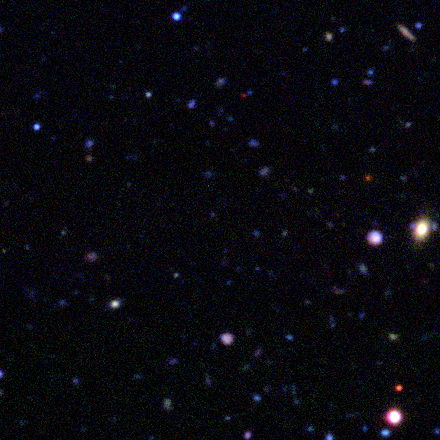
http://talk.spacewarps.org/#/subjects/ASW0004id9
Third question, how dim can we expect quasar points to be. There are many images with dim blue stars being posted in Recent. In the SDSS telescope survey, quasars were always bright enough to look like a small bright star.
When I look at a blue fuzzy area, I ask myself "If that was further away from the galaxy, would I think it was usual?"
Can I assume that quasars points must always be small and bright, like the images in Spotter's Guide?
Can the light from one or more of the quasar points be blocked by the thicker parts of the galaxy, producing a "single double" or a "triple quad" ?
Posted
-
 by
c_cld
by
c_cld
Example of known catalogued quasars in CFTHLS Wide fields cross-matched with VII/258/vv10 table
order by spectroscopic redshiftSDSS J140604.24+572956.6 1237659326016585782 z 0.326
SDSS J222220.97+005709.4 1237678617407128166 z 0.770
SDSS J135711.23+555804.9 1237661418748248217 z 0.940
SDSS J022706.81-090717.1 1237653500969418799 z 0.960
SDSS J140954.00+544414.4 1237661387604492350 z 1.050
SDSS J140326.91+561307.3 1237659324406038647 z 1.074
SDSS J022600.02-035954.4 1237679254672375924 z(~) 1.095
SDSS J141059.36+570829.4 1237659326016913547 z 1.580
SDSS J221227.74+005140.7 1237663480332419340 z 1.773
SDSS J022914.12-075737.3 1237673701279203406 z 2.488
SDSS J143022.34+565712.5 1237659327091769723 z 4.561
SDSS J023137.64-072854.4 1237673701279531827 z 5.421
I found that these examples have little similarity with sims or with objects posted on #quasar hashtag :-😉
Posted
-
 by
c_cld
in response to Budgieye's comment.
by
c_cld
in response to Budgieye's comment.
On #quad it's interesting to learn the case of A quadruply imaged quasar with an optical Einstein ring
candidate: 1RXS J113155.4−123155 arXiv:astro-ph/0307345 from D. Sluse et al.Abstract. We report the discovery of a new quadruply imaged quasar surrounded by an optical Einstein ring candidate. Spectra of the different components of 1RXS J113155.4−123155 reveal a source at z = 0.658. Up to now, this object is the closest known gravitationally lensed quasar. The lensing galaxy is clearly detected. Its redshift is measured to be z = 0.295.
conclusion quote:
'This bright system brings together rare properties (i.e. quad, bright optical Einstein ring, small redshift, high amplification), nearly unique among the known gravitational lens systems. These features make 1RXS J113155.4−123155 a very promising astrophysical laboratory for future investigations, including the possibility for an independent determination of the Hubble parameter H0 based on time delay measurements.'Posted
-
 by
c_cld
in response to Budgieye's comment.
by
c_cld
in response to Budgieye's comment.
about the third question on dim quasar:
the faintest cross-match is SDSS J021827.30-053457.5 1237679321787400654 redshift: 2.583
CFHTLS gri 60 arcseconds square
somewhat noisy, could get a better contrast in Space Warps, particulary in bluer 😃
Posted
-
 by
c_cld
in response to Budgieye's comment.
by
c_cld
in response to Budgieye's comment.
2nd part of third question: blocked images of lensed object (not restricted to AGN/QSO, could be galaxy)
see post of "Einstein Cross"
SDSS J141735.73+522646.3 1237661416065663689 z lens= 0.811
z source = 3.4#quad by HST view or by ugr img form Terapix, but triple in gri.
Only double within frame like those presented here (60" square):
results vary with resolution but depend also on image processing and zooming capabilities within noise limitations and pixelization!
Posted
-
 by
Budgieye
moderator
by
Budgieye
moderator
Thank you for your hard work, c_cld. I will get back to this in a few days.
Posted
-
 by
c_cld
by
c_cld
Illustration of a background quasar 1237656567583670573 (z spec. 2.857) in the arms of a foreground spiral 1237656567583670572 (z spec.0.095)
SDSS
CFHTLS 60 arcseconds square
seen from terapix
gri
ugr
#overlap 😃
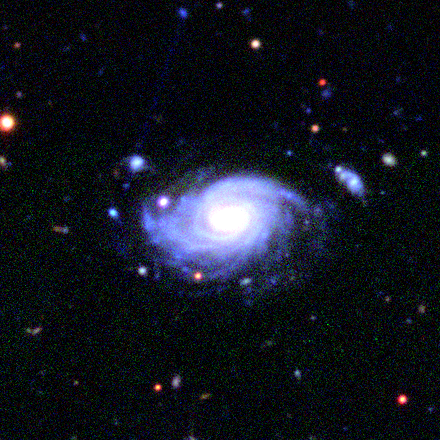
Posted
-
 by
Budgieye
moderator
by
Budgieye
moderator
Some of the quasar points are fuzzier than I would have hoped, though some are small bright with clean edges. It certainly shows the importance of colour images.
Posted
-
 by
Budgieye
moderator
by
Budgieye
moderator
Looking at your analysis of colour of Hubble lens candidate, HST14176+5226 in the Galaxy Zoo forum,
you presented the gri image of the candidate, such as we would see in our SpaceWarps image
I am amazed at how pink or light blue the arcs are. However, this is still only a lens candidate, not a proven lens. Also, they do say that the points look like arcs (ie from a lensed galaxy) not quasar points (ie from a quasar)
Posted
-
 by
Budgieye
moderator
by
Budgieye
moderator
Proven lensed quasars copied from my spotter's guide on Galaxy Zoo Forum http://www.galaxyzooforum.org/index.php?topic=275811.0. I have tried to match SDSS image size and magnification for the Recent page (magnification 0.2 and image size 360 pix). CFHT will have sharper images, but the colour and size should be about the same.
http://cas.sdss.org/astro/en/tools/explore/obj.asp?id=587729388218679312
z=1.41 Those two “stars” are lensed light from one quasar.
This object is the first example of a gravitational lens
the massive lensing elliptical galaxy, seen between them,
lies at redshift z = 0.355 (3.7 billion ly)
The distant quasar lies at redshift z = 1.41 (8.7 billion ly)
1979 The Twin Quasar http://adsabs.harvard.edu/cgi-bin/bib_query?1979Nat...279..381W
"Q0957+561 A, B: Twin Quasistellar Objects or Gravitational Lens?They are bright enough using the SDSS telescope, so should be even brighter in the CFHT telescope.
http://cas.sdss.org/dr7/en/tools/explore/obj.asp?id=588297863111180358
z=1.73 2003 http://arxiv.org/abs/astro-ph/0312427
"A gravitationally lensed quasar with quadruple images separated by 14.62arcseconds"There have been many lensed quasars found, but this has a wide separation between lensed galaxies
The orange massive galaxy has z= 0.67
It has two nearby companions at z=0.67
The lensed quasar is in 4 arcs, at z=1.73These quasar points are a far away from the lensing galaxy, 14.62 " , say 15" is about a quarter of the way across one of our images (60").
http://cas.sdss.org/astro/en/tools/explore/obj.asp?id=588017726004396138
z=2.024 The triple quasar Q1115+080A, B, C - A quintuple gravitational lens image
http://adsabs.harvard.edu/cgi-bin/bib_query?1979Nat...279..381W
PG 1115+080 A gravitational cloverleaf Hazard, et al 1984, ApJ, 282
Astronomy Picture of the Day March 31, 1999
and ChandraI believe that lens arcs and points are always odd numbers. So a quad must have another point hidden by the lensing galaxy.
http://cas.sdss.org/dr7/en/tools/explore/obj.asp?ra=08:20:16.1 &dec= +08:12:16
z=2.024
2009 SDSS J082016.11+081215.9 http://arxiv.org/abs/0906.2647
"A new gravitational lens from the MUSCLES survey: ULAS J082016.1+081216"
The lens galaxy as a faint red object of redshift 0.803
The lensed quasar has a double image (not really visible in SDSS) and z= 2.024I wouldn't guess that this was a lens
http://cas.sdss.org/astro/en/tools/chart/chart.asp?ra=124.99826353&dec=53.94036891
z=2.237 2009 SDSS J0819+5356
red lensing galaxy z=0.294
lensed quasar, blue 4" to north west, z=2.237,
listed as a star on NED
spectrum evidently a mix of the red galaxy and the quasar
“Five New High-Redshift Quasar Lenses from the Sloan Digital Sky Survey”
2009 http://arxiv.org/abs/0809.0912
http://cas.sdss.org/astro/en/tools/explore/obj.asp?ra=204.77974079&dec=13.17767316
z=2.241 2009 SDSS J1339+1310
double quasarhttp://cas.sdss.org/astro/en/tools/explore/obj.asp?ra=194.580190&dec=+16.954910
double quasar z=3.317 posted by 1000GGG, AlexandredOr suggested that it might be a lens
http://cas.sdss.org/astro/en/tools/explore/obj.asp?ra=193.578960&dec=+22.593500
double green quasar z=3.626
“Five New High-Redshift Quasar Lenses from the Sloan Digital Sky Survey”
2009 http://arxiv.org/abs/0809.0912
All these examples are BRIGHT!
Posted
-
 by
Budgieye
moderator
by
Budgieye
moderator
a quasar double from the known candidate list
SA46

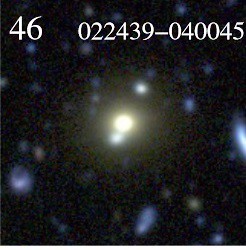
Posted
-
 by
c_cld
by
c_cld
SDSS J022439.06-040045.1 1237679254672245038 ra,dec 36.16276, -4.01254
http://talk.spacewarps.org/#/subjects/ASW0009ah7
Posted
